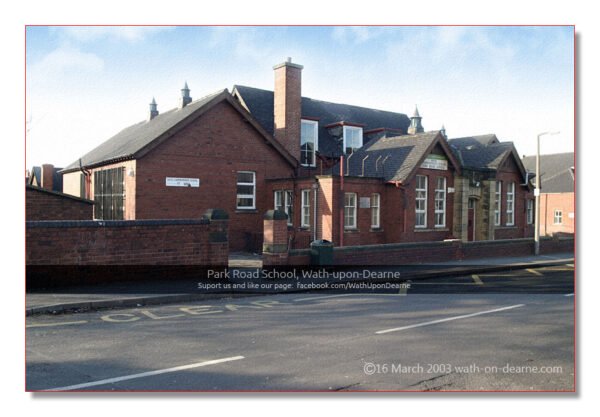Let’s take a trip down memory lane and journey back to the quaint town of Wath-upon-Dearne in the early 2000s. Two important establishments defined the town’s landscape: the “Park Road Secondary Modern School” and “Wath Park Road Primary School.” Sadly, the old saying “all good things must come to an end” rings true here, as these institutions were reduced to rubble by the Rotherham Metropolitan Borough Council for reasons relating to land sales. Enter Gleeson Builders, the new owners of the plot, and the history-soaked schools were no more.
However, the educational spirit of Wath-upon-Dearne wasn’t born overnight. The roots stretch deep into the past, tracing their origins back to the 1600s. Fast forward to the 1870s, and grammar schools began to bloom, blossoming into respected institutions. Entry to these prestigious halls was based on entrance exams, a testament to their reputation as gateways to success. As trailblazers in education, they became models for the tiered structure adopted by the British education reforms of the 1940s.
But let’s rewind a bit. Before 1944, access to secondary education in Britain was as varied as a patchwork quilt, depending on location and resources. Schools were established by local governments, charities, and religious foundations, but not all could attend, and the financial backing was sporadic. In fact, by 1938, only a tiny fraction of working-class kids aged 13 were still in school. It was mostly the privilege of the middle class.
Fast forward again, and during the reign of Conservative governments from 1951 to 1964, the prevailing system divided students into different types of schools based on their performance in the 11-plus or 13-plus exam. However, when Labour came into power post-1964, they frown upon this division. By 1976, England and Wales bid adieu to this system, welcoming the comprehensive system with open arms.
What was a secondary modern school, you ask? It was a significant part of the Tripartite System, which was in effect from 1944 until the 1970s in England, Wales, and Northern Ireland. According to the Education Act of 1944 and the Northern Irish equivalent from 1947, state-funded secondary education was categorized into grammar schools, secondary technical schools, and secondary modern schools. However, not all regions were on board with this system, with some only maintaining grammar and secondary modern schools.
The Education Act of 1944 was an education earthquake, shaking up the landscape in monumental ways. It redefined primary and secondary education, wiped out fees for state secondary schools, introduced a fairer funding system, and transformed the Board of Education into the Ministry of Education, granting it more authority and resources. The official school-leaving age was set at 15, with a future provision to increase it to 16 when feasible, a change that materialized in 1973.
The act also made it mandatory for local authorities to serve school meals and milk. From August 1946, all under-18s in maintained schools started receiving free school milk. But as time rolled on, the milk slowly disappeared from older students’ hands. The most notable cuts happened under Margaret Thatcher in 1971 and Shirley Williams in 1977, leading to quite the controversy.
Now, let’s revisit our dear Wath-upon-Dearne. Wath Secondary School threw open its doors to knowledge-seekers on September 17, 1923, under the supervision of Alderman Talbot. Initially based out of Park Road Infants School with just 77 children, it soon expanded to accommodate a booming 520-strong student body within six years, commandeering space from local churches and the Wath Mechanics Institute.
The Wath (Park Road) Secondary Modern School, originally known as Wath Park Road Council School in the 1930s, operated as a secondary modern school until its closure in December 1963. Its students found a new academic home in the neighbouring Wath Grammar School, bumping up the student count to 1491. The old school building served as the basic wing for these students, later turning into Wath’s Year 7 wing until its eventual demolition in 2005.
Sharing a fence with the Secondary Modern School was Wath Park Road Primary School, a nurturing place for 3-7 year olds under the watchful eye of head teacher Mrs. N. Trickett. But on September 12, 2005, the school bell tolled for the last time, as it merged with another establishment, making way for Gleeson Builders’ redevelopment plans.
Reflecting on these historical educational shifts, we see room for growth. The tripartite system’s division created a hierarchy that often skewed opportunities, and the allocation of students based on exams amplified social divides. Its replacement, the comprehensive system, strived for equality, but hurdles remain in ensuring a supportive, diverse learning environment.
Moreover, the controversial milk withdrawals sparked debates about children’s essential needs. Policymakers should consider the potential impact of such decisions, especially on students from varying socioeconomic backgrounds.
As for infrastructure, demolishing historical school buildings like those in Wath-upon-Dearne may erase pieces of cultural heritage. Preservation and repurposing could provide unique learning spaces and link us to our past.
So, in the quest to enhance UK education, we must prioritize equal access to quality education, invest in teacher development, promote inclusivity and diversity in the curriculum, and create supportive learning environments. Moreover, preserving historical buildings can help instil a sense of pride and identity in students, forming a bridge from the past into a better future.
Thank you for joining us on this trip down memory lane. Our journey through Wath-upon-Dearne’s educational history is but a small fragment of the vast tapestry of education in the United Kingdom. Surely, each of us carries a piece of this shared past, a memory, a story, or an anecdote.
Perhaps you were once a student at one of these historic schools, or you’ve heard stories passed down through generations about the schoolyard games or the inspiring teachers who walked these corridors. Maybe your family traces its roots to the area, or you have memories linked to these iconic buildings that once stood proudly.
Or, if you’re an educator, what are your thoughts about the shift from the tripartite to the comprehensive system? How have you seen this evolve in your career, and what lessons can be learned from our past to shape the future of education?
Perhaps you are an architect, town planner, or historian. What are your thoughts on preserving historical buildings, like schools, to foster community and continuity in rapidly changing urban landscapes?
We’d love to hear your thoughts, stories, and perspectives. After all, history isn’t just about facts and figures. It’s about people, their stories, and their experiences. So, let’s continue this conversation. Share your piece of the puzzle and help paint a richer, more vibrant picture of our shared educational heritage. Your words might just inspire others to join in, learn from the past, and shape the future.
Editors Comment:
As an editor, I’m fascinated by how our journey through Wath-upon-Dearne’s educational past has touched upon larger themes within British education. It’s a poignant reminder of the constant ebb and flow of change in our schooling systems, a dance between tradition and innovation. Looking back on these transitions, it’s crucial to take stock and learn, ensuring our future is built on lessons well learnt. From the tripartite system’s selective pressures to the more egalitarian approach of the comprehensive system, we see a continual striving for equity and inclusivity that still informs our educational debates today.
Yet what truly resonates is the human element woven through this story. The teachers shaping young minds, the students growing in knowledge, the policy-makers defining educational paths – these are the figures behind the facts. The transformation of Wath-upon-Dearne’s schools and their eventual loss echoes a common experience across the UK, where change often arrives with a bittersweet taste. As we move forward, let’s remember the importance of preserving our past, the structures and stories that tell us who we are. They serve as signposts guiding us towards a future where education opens doors for everyone, a future we can all be proud of.


Leave a Comment